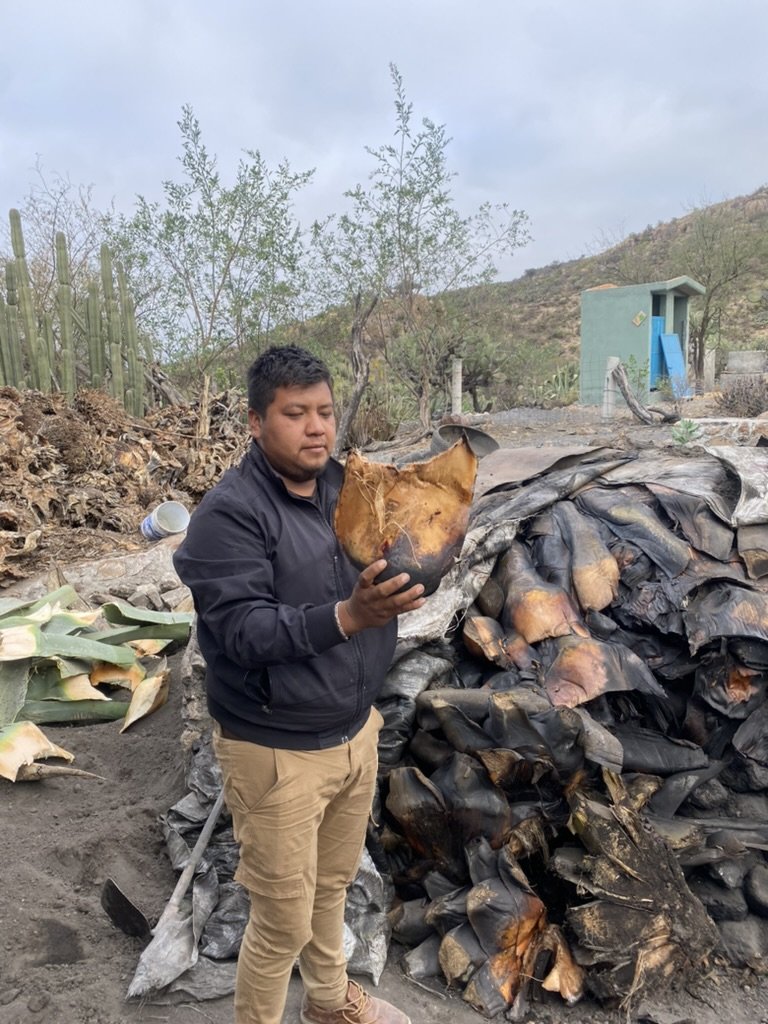salmiana silvestre - palmar segundo
Batch: SLP-MN-01
Release date: April 2025
Just 30 minutes north of the city of San Luis Potosí, one of Mexico’s old gold mining centres, multiple generations of mezcal makers are proudly representing their entirely unique ‘campanilla’ heritage style of working with agave.
We are honoured to have the chance to represent their work across the ocean, and pleased to present this bottling - our first from the state of San Luis Potosí.
The only family of agave to grow in this region is the Salmiana. But there are 4 distinct varieties, which grow to vastly different proportions: Chino, Querno, Blanco, and Verde (also known as ‘silvestre’. While batches are often made with a mix of these varieties, this one is 100% maguey Verde/silvestre - ‘wild’.
For more on the diversity of Salmiana in central Mexico, check out this release from over the state border in Guanajuato - GUA-PV-01.
The whole production process in this community is quite wildly different to anything we’ve seen before.
Firstly the roasting process, pictured below. There’s a solid wall of rocks with an entrance below in which to build a fire. Rather than remove the rocks between each roast (as with a regularly seen mezcal horno) the fire in the dug-out hole heats the permanent wall of rocks, on which the agave leaves are laid to roast. It’s smart, and it means there’s no direct contact of fire or smoke in the cooking process. A roast is generally 3 days.
After roasting comes milling, and here in Palmar Segundo that’s done with a horse drawn tahona. The tahona is made from a tractor tyre filled with concrete.
Fresh roast Agave Salmiana
Fuelling up for work
Gently does it
Once crushed by the tahona, the smashed agave is loaded into a kind of hammock that sits above a drainage system. The hammock it twisted tight at the ends, to squeeze out all of the sweet agave syrup from the roasted agave.
The apparatus are built so that the juice runs off into a concrete vat (seen in the pic above with the fly net on top), and this is where things get really interesting at the Campanilla compound. Each roast will create about 70 litres of squeezed agave juice. Over a 6 day fermentation period, 40 litres of pulque are added to the mix.
Pulque is the fermented sugary water that can be collected from the heart of a live agave plant. And this is one of only a small handful of places we’ve seen anything added to the fermentation in this way.
After fermentation, everything is double distilled in the unique Campanilla clay pot still.
5 different tall clay pot boiling chambers are built into a stone oven with a single fire beneath them all. More of the same tall clay pots sit on top as cooling chambers, and atop those sit copper condensing lid.
Beneath the copper condensing lid, ‘floating’ inside the cooling pot, a smaller clay pot is suspended using the balancing weight of two agave leaves. This where the re-condensed spirit is collected as it drips from the underside of the lid. The pot is called, ‘Campanilla’.
Without running water in the palenque, the water keeping the copper cooling lid operational must be changed manually. Tradition and experience says it takes 9 rounds of the heated water being changed for the distillation to be finished. Each time the water is changed, the cooling chamber is marked with chalk. 9 chalk lines = finished distillation run.
A little mezcal maths from Campanilla:
It takes between 40-60kg of raw harvested agave Salmiana to make a single litre of finished mezcal.
A complete batch from this oven generally comes in between 50-60 litres.
The palenque is making 3 or 4 batches each month on average (tiny scale production)
For each 70 litres of sweet squeezed agave juice, 40 litres of pulque are added to the fermentation.
Gracias Manuel
Tasting notes:
Nose: Perfumed with floral notes of Jasmin and gardenia, layers of green vegetation a rich woody depth lurking.
Palate: More earthiness upfront on first sip with tones of pine and leather. The pulque in the ferment makes itself known in the mid-palate with an almost effervescent quality and a kind of ‘grip’ to the mouth feel - something really unique to pulque fermented distillations, in our experience.
Finish: The leather becomes almost meaty before giving way to a lingering finish of toasted coco nibs, with faint reminders of those early floral flavours creeping in and beckoning another sip. Spectacular.
Grab a bottle for your collection while stocks last:
Continue your agave spirits journey via the Mezcal Appreciation Society:





















